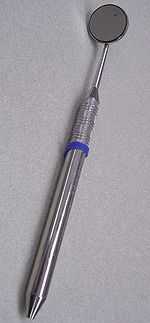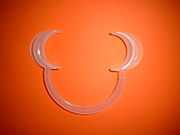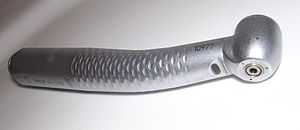Dental instruments

Dental instruments are the tools that dental professionals use to provide dental treatment. They include tools to examine, manipulate, restore and remove teeth and surrounding oral structures.
Standard instruments are the instruments used to examine, restore and extract teeth and manipulate tissues.
Examination instruments
These tools allow the dental professional to manipulate tissues for better visual access during treatment or during dental examination.
Mirror
Dental mirrors are used by the dentist or dental auxiliary to view a mirror image of the teeth in locations of the mouth where visibility is difficult or impossible. They also are used for reflecting light onto desired surfaces, indirect vision, and with retraction of soft tissues to improve access or vision.
Probes
- Dental explorer (sickle probe)
- Periodontal probe
- Straight probe
Retractors

- Mouth prop
- Dental mirror
- Cheek retractor
- Tongue retractor
- Lip retractor
Local anesthesia
- Dental anesthesia and dental syringe
About Anesthesia Anesthesia is broken down into three main categories: local, regional, and general, all of which affect the nervous system in some way and can be administered using various methods and different medications.
Here's a basic look at each kind:
Local anesthesia. An anesthetic drug (which can be given as a shot, spray, or ointment) numbs only a small, specific area of the body (for example, a foot, hand, or patch of skin). With local anesthesia, a person is awake or sedated, depending on what is needed. Local anesthesia lasts for a short period of time and is often used for minor outpatient procedures (when patients come in for surgery and can go home that same day). For someone having outpatient surgery in a clinic or doctor's office (such as the dentist or dermatologist), this is probably the type of anesthetic used. The medicine used can numb the area during the procedure and for a short time afterwards to help control post-surgery discomfort.
Dental drills

Dental handpieces come in many varying types which include: High speed air driven (also known as an airotor), slow speed, friction grip, surgical hand piece. Straight handpiece with a sharp bur.
Dental laser
A dental laser is a type of laser designed specifically for use in oral surgery or dentistry.
The use of a laser can decrease morbidity after surgery, and reduces the need for anesthetics. Because of the cauterization of tissue there will be little bleeding following soft tissue procedures, and some of the risks of alternative electrosurgery procedures are avoided.
Dental torque wrench
A dental torque wrench or restorative torque wrench is a torque wrench used to precisely apply a specific torque to a fastener bolt for fixation of an abutment, dentures or prostetics on a dental implant.[1]
Burs
Dental Burs cutting surface are either made of a multifluted tungsten carbide, a diamond coated tip or a stainless steel multi fluted rosehead. There are many different types and classifications of burs some of the most common are: the round bur (sizes ¼ to 10) or inverted cone (sizes 33½ to 90L). Burs are also classified by the type of shank. For instance a latch type, or right angle bur is only used in the slow speed handpiece with contra-angle attachment. Long shank or shaft is only used in the slow speed when the contra-angle is not in use, and finally a friction grip bur which is a small bur used only in the high-speed handpiece.
There are many bur shapes that are utilized in various specific procedures.
Operative burs
Flat fissure, pear-shaped, football, round, tapered, flame, chamfer, bevel, end cut, bud bur, steel, inverted cone, diamond, brown stone, and greenstone.
Restorative instruments
Excavators
- Spoon excavator: which is used to remove soft carious decay
- Half hollenbach: this instrument is usually used to test for overhangs or flash
- Chisels:
- Straight - bevels the cavosurface margin and used in 3, 4 and 5 classifications of cavities on the maxillary.
- Wedelstaedt - only used in the anterior for classes 3, 4 and 5 as well.
- Bin Angle - this is held in a pen grasp and used for class 2 maxillary only.wheel shape bur
Burnishers
- Flat plastic
- Ball burnisher
- Beavertail burnisher
- Cone burnisher
- Pear shaped burnisher
- Cone burnisher
Pluggers
Pluggers are also known as amalgam condensers.
- Amalgam plugger
- 49 plugger.
Periodontal scalers
Curettes
Types include:
- Universal curettes - these have a semicircular tip used at 90° to the tooth root surface.
- Gracey curettes - semicircle tipped, but one edge lower than the other, used at 70° to the tooth root surface.
Prosthodontic instruments
Removable prosthodontics
- Spatula
- Fox plane
- Willis gauge
- Bunsen burner
- Wax knife
- Le cron
- Calipers
- articulator
- wax carver
- face bow
Extraction/surgical instruments
Dental forceps
- Cow horns #23
- Upper universals
- Upper universal fine
- Lower universals
- Upper canine
- Upper straight long
- Upper straight short
- Upper right molar
- Upper left molar
- Upper wisdom tooth
- Greyhound
- Root
- Bayonet
Elevators
- Narrow and wide, straight and curved luxators
- Couplands elevator
- Warwick James elevator
- Cryer elevator
- Periosteal elevator
- Root-tip pick elevator
- Potts elevator
- Cogswell-A elevator
Chisels
Orthodontic instruments
- Ligature
- Distal end cutters
- Brakete holder
- Band busher
- Methiose
- Band Seter
- Hemostat/Mathieu pliers
Endodontic instruments
- K-file
- Hedstrom file
- Gates glidden
- Finger spreader
- Lentulo spiral
- Endodontic explorer
- Apex locator
- Microscope
See also
References
| ||||||||||||||||||||||||||||||||||||||||
| ||||||||||||||||||||||||||